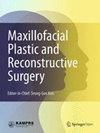Specially designed and CAD/CAM manufactured allogeneic bone blocks using for augmentation of a highly atrophic maxilla show a stable base for an all-on-six treatment concept: a case report
IF 2
Q2 DENTISTRY, ORAL SURGERY & MEDICINE
Maxillofacial Plastic and Reconstructive Surgery
Pub Date : 2022-05-24
DOI:10.1186/s40902-022-00351-9
引用次数: 2
Abstract
In terms of a highly atrophic maxilla, bone augmentation still remains very challenging. With the introduction of computer-aided design/computer-aided manufacturing (CAD/CAM) for allogeneic bone blocks, a new method for the treatment of bone deficiencies was created. This case report demonstrates the successful use of two specially designed and CAD/CAM manufactured allogeneic bone blocks for a full arch reconstruction of a highly atrophic maxilla with an all-on-six concept. We report the case of a 55-year-old male patient with a highly atrophic maxilla and severe bone volume deficiencies in horizontal and vertical lines. In order to treat the defects, the surgeon decided to use a combination of two allogeneic bone blocks and two sinus floor augmentations. The bone blocks were fabricated from the data of a cone beam computed tomography (CBCT) using CAD/CAM technology. After the insertion of the two bone blocks and a healing period of 7 months, six dental implants were placed in terms of an all-on-six concept. The loading of the implants took place after an additional healing time of 7 months with a screw-retained prosthetic construction and with a milled titanium framework with acrylic veneers. The presented procedure shows the importance of the precise design of CAD/CAM manufactured allogeneic bone blocks for the successful treatment of a highly atrophic maxilla. Proper soft-tissue management is one of the key factors to apply this method successfully.特别设计和CAD/CAM制造的同种异体骨块用于增强高度萎缩的上颌骨,为全对六治疗概念提供了稳定的基础:一个病例报告
就高度萎缩的上颌骨而言,骨增强术仍然非常具有挑战性。异体骨块的计算机辅助设计/计算机辅助制造(CAD/CAM)技术的引入,为骨缺损的治疗创造了一种新的方法。本病例报告展示了两个特别设计和CAD/CAM制造的同种异体骨块的成功应用,用于高度萎缩的上颌全弓重建。我们报告的情况下,55岁的男性患者高度萎缩的上颌骨和严重的骨量不足,在水平和垂直线。为了治疗缺陷,外科医生决定使用两个异体骨块和两个窦底增强的组合。采用CAD/CAM技术从锥形束计算机断层扫描(CBCT)的数据制作骨块。在植入两个骨块和7个月的愈合期后,按照全-六的概念放置了六颗牙种植体。植入物的加载是在螺钉保留假体结构和磨钛框架与丙烯酸贴面的额外愈合时间7个月后进行的。本研究显示了CAD/CAM制造的同种异体骨块的精确设计对于成功治疗高度萎缩的上颌骨的重要性。正确的软组织处理是该方法成功应用的关键因素之一。
本文章由计算机程序翻译,如有差异,请以英文原文为准。
求助全文
约1分钟内获得全文
求助全文
来源期刊

Maxillofacial Plastic and Reconstructive Surgery
DENTISTRY, ORAL SURGERY & MEDICINE-
CiteScore
4.30
自引率
13.00%
发文量
37
审稿时长
13 weeks
 求助内容:
求助内容: 应助结果提醒方式:
应助结果提醒方式:


